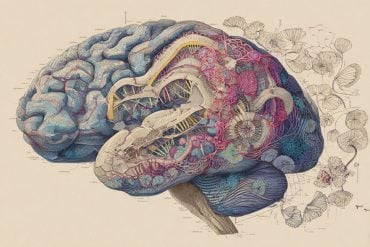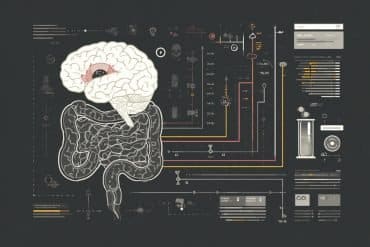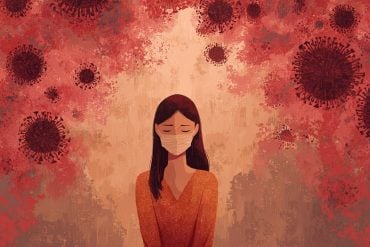Summary: People with a life-long history of antisocial behavior had decreased mean surface area of the brain and lower mean cortical thickness than those with no history of antisocial behavior. Much of the cortical thinning was in areas associated with emotional regulation, motivation, and goal-directed behavior.
Source: The Lancet
Individuals who exhibit life-course-persistent antisocial behaviour – for example, stealing, aggression and violence, bullying, lying, or repeated failure to take care of work or school responsibilities – may have thinner cortex and smaller surface area in regions of the brain previously implicated in studies of antisocial behaviour more broadly, compared to individuals without antisocial behaviour, according to an observational study of 672 participants published in The Lancet Psychiatry journal.
However, there were no widespread structural brain abnormalities observed in a larger group of individuals who exhibited antisocial behaviour only during adolescence.
Previous epidemiological studies have demonstrated marked individual differences in the age of onset and duration of antisocial behaviour. Some individuals display life-course-persistent antisocial behaviour that begins in childhood and lasts into adulthood, whereas for others antisocial behaviour arises in adolescence but desists as they mature into adulthood.
The study is the first to compare structural brain differences using neuroimaging in individuals with either life-course-persistent or adolescent-only antisocial behaviour and those without antisocial behaviour, providing the first robust evidence to suggest that underlying neuropsychological differences are primarily associated with life-course-persistent persistent antisocial behaviour.
Lead author Dr Christina Carlisi, UCL, UK, says: “Our findings support the idea that, for the small proportion of individuals with life-course-persistent antisocial behaviour, there may be differences in their brain structure that make it difficult for them to develop social skills that prevent them from engaging in antisocial behaviour. These people could benefit from more support throughout their lives.”
Continuing, she cautions: “Most people who exhibit antisocial behaviour primarily do so only in adolescence, likely as a result of navigating socially difficult years, and these individuals do not display structural brain differences. It is also these individuals who are generally capable of reform and go on to become valuable members of society.”
The study used MRI brain scans from 672 participants aged 45 years. Based on reports from parents, carers and teachers, as well as self-reports of conduct problems between ages seven and 26 years old, the 672 participants were previously categorised in terms of the patterns of behaviour they exhibited – 12% (80 people) had life-course-persistent antisocial behaviour, 23% (151) had adolescent-only antisocial behaviour, and 66% (441) had no history of persistent antisocial behaviour.
Analysing the brain scans, the authors measured and compared the average cortical thickness and cortical surface area (indices of grey matter – a type of brain tissue – size), between these three groups. They also analysed differences in the surface area and cortical thickness of 360 different regions of the cortex.
On average, across the entire brain, individuals with life-course-persistent antisocial behaviour had a smaller mean surface area and lower mean cortical thickness than people who showed no persistent antisocial behaviour. In addition, people who showed life-course-persistent antisocial behaviour had reduced surface area in 282 of 360 brain regions, and had thinner cortex in 11 of 360 regions, most of which have been previously linked to antisocial behaviour through their involvement in goal-directed behaviour, regulation of emotions, and motivation.
However, widespread differences in brain structure were not found for the adolescence-limited group compared with either non-antisocial or life-course-persistent antisocial groups.
The authors say their findings provide the first robust evidence to suggest that underlying neuropsychological differences exist in people with life-course-persistent antisocial behaviour and have implications for the way we treat juvenile offenders.
Adolescents exhibiting life-course-persistent antisocial behaviour which began in childhood are often diagnosed with conduct disorder, and these children are at an increased risk for incarceration and poor physical and mental health later in life.

Co-author Terrie Moffitt, Duke University, USA, says: “Political approaches to juvenile offending often swing back and forth between punitive measures and approaches that give young offenders room to reform. Our findings support the need for different approaches for different offenders – however, we caution against brain imaging being used for screening, as the understanding of brain structure differences are not robust enough to be applied on an individual level. Instead, we need to recognise that individual development can be one driver of serious repeat offending, but to also appreciate that this is not the case for all juvenile offenders.” [1]
Acknowledging the limitations of their study, co-author Professor Essi Viding, UCL, UK, cautions: “It is unclear whether these brain differences are inherited and precede antisocial behaviour, or whether they are the result of a lifetime of confounding risk factors (eg, substance abuse, low IQ, and mental health problems) and are therefore a consequence of a persistently antisocial lifestyle.”
The authors call for more long-term studies of antisocial behaviour which include multiple measurements of behaviour, brain, genes, and environment to understand how life-course-persistent antisocial behaviour unfolds.
Funding:
Source:
The Lancet
Media Contacts:
Lancet Press Office – The Lancet
Image Source:
The image is in the public domain.
Original Research: Open access
“Associations between life-course-persistent antisocial behaviour and brain structure in a population-representative longitudinal birth cohort”. Christina Carlisi et al.
The Lancet Psychiatry doi:10.1016/S2215-0366(20)30002-X.
Abstract
Associations between life-course-persistent antisocial behaviour and brain structure in a population-representative longitudinal birth cohort
Background
Studies with behavioural and neuropsychological tests have supported the developmental taxonomy theory of antisocial behaviour, which specifies abnormal brain development as a fundamental aspect of life-course-persistent antisocial behaviour, but no study has characterised features of brain structure associated with life-course-persistent versus adolescence-limited trajectories, as defined by prospective data. We aimed to determine whether life-course-persistent antisocial behaviour is associated with neurocognitive abnormalities by testing the hypothesis that it is also associated with brain structure abnormalities.
Methods
We used structural MRI data collected at 45 years of age from participants in the Dunedin Study, a population-representative longitudinal birth cohort of 1037 individuals born between April 1, 1972, and March 31, 1973, in Dunedin, New Zealand, who were resident in the province and who participated in the first assessment at 3 years of age. Participants underwent MRI, and mean global cortical surface area and cortical thickness were extracted for each participant. Participants had been previously subtyped as exhibiting life-course-persistent, adolescence-limited, or no history of persistent antisocial behaviour (ie, a low trajectory group) based on informant-reported and self-reported conduct problems from the ages of 7 years to 26 years. Study personnel who processed the MRI images were masked to antisocial group membership. We used linear estimated ordinary least squares regressions to compare each antisocial trajectory group (life-course persistent and adolescence limited) with the low trajectory group to examine whether antisocial behaviour was related to abnormalities in mean global surface area and mean cortical thickness. Next, we used parcel-wise linear regressions to identify antisocial trajectory group differences in surface area and cortical thickness. All results were controlled for sex and false discovery rate corrected.
Findings
Data from 672 participants were analysed, and 80 (12%) were classified as having life-course-persistent antisocial behaviour, 151 (23%) as having adolescence-limited antisocial behaviour, and 441 (66%) as having low antisocial behaviour. Individuals on the life-course-persistent trajectory had a smaller mean surface area (standardised β=–0·18 [95% CI −0·24 to −0·11]; p<0·0001) and lower mean cortical thickness (standardised β=–0·10 [95% CI −0·19 to −0·02]; p=0·020) than did those in the low group. Compared with the low group, the life-course-persistent group had reduced surface area in 282 of 360 anatomically defined parcels and thinner cortex in 11 of 360 parcels encompassing circumscribed frontal and temporal regions associated with executive function, affect regulation, and motivation. Widespread differences in brain surface morphometry were not observed for the adolescence-limited group compared with either non-antisocial behaviour or life-course-persistent groups.
Interpretation
These analyses provide initial evidence that differences in brain surface morphometry are associated with life-course-persistent, but not adolescence-limited, antisocial behaviour. As such, the analyses are consistent with the developmental taxonomy theory of antisocial behaviour and highlight the importance of using prospective longitudinal data to define different patterns of antisocial behaviour development.






